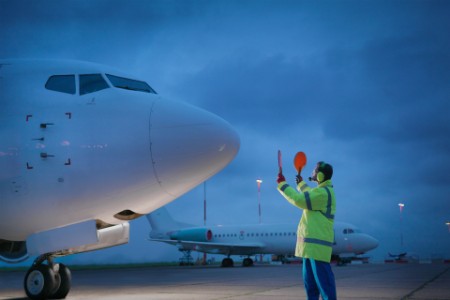
Chapter 1
Addressing two wild cards: aviation supply chain and labor
Supplier distress and a pool of talent with new priorities amid the pandemic add to the uncertainty. Here’s how to navigate the new normal.
The current state of A&D supply chains
OEMs are facing a heady mix of labor shortages, supply chain issues and high prices of raw materials, all signaling a potential threat to component availability.
Within supply chains, the impact of the war in Ukraine has been limited. Although commercial OEMs have relied heavily on Russian titanium, they likely have enough supply to meet near-term needs, as they have been stockpiling reserves and building alternative sourcing strategies for some years now. A larger disruptive source remains in the market: distressed suppliers on uncertain footing since the pandemic began and still confronting uncertainty in demand.
To help distressed suppliers navigate near-term cash flow pressures, OEMs have offered financial aid, accelerated payments and set up “watchtowers” to detect financial problems. Governments have offered billions in grants, loans and guarantees as well, and Tier 1 suppliers have chipped in with contract extensions, inventory purchases and vendor financing programs. Even so, the smaller suppliers facing maximum pressure have been consolidating on a large scale.
Recommended actions: To maintain the long-term viability of their supply chains, major A&D companies have to continue to proactively identify distress and perform proactive evaluations. OEMs may need to acquire major suppliers and insource to protect jobs and increase capacity utilization, as well as invest in strategic technologies.
Workforce challenges
Meanwhile, the pandemic has scrambled the availability of labor and created new priorities among workforces, resulting in a drift away from traditional manufacturing roles. In the EY 2021 A&D Workforce Study (via EY.com US), EY teams found that flexibility reigns supreme today, as it has been shown to be both possible and preferable. In the US, about 26% of the A&D workforce is over age 55 (higher than the average across industries), and voluntary attrition rates are above average as well. Manufacturers should expect a wave of retirements amid the “great resignation.” Meanwhile, digital and analytical talent — core to how the sector drives innovation and achieves next-generation operations — is more necessary than ever.
Recommended actions: To the extent possible, invest in enabling technology for remote work, which aligns with flexibility and greater safety, and make accommodations for flexible work arrangements (such as the start and finish times and compressed workweeks).
Also, explore the top three differentiated benefits, as cited in EY workplace survey: recognition, career development opportunities and tuition reimbursement. The second perk can be tied to upskilling, into the much-needed areas of engineering, cybersecurity and digital. Specify needed skills and partner with universities whose curriculums produce qualified candidates and augment your talent pipeline through institutions conducting research in areas of interest.

Chapter 2
Digital and sustainability: achieving efficiencies and growth
Technologies like AI hold promise for aerospace companies and ESG should be high on the agenda. Meanwhile, new opportunities are on the horizon.
Digital presents a new opportunity across value streams, enabling A&D players to design, build and service products with greater speed, efficiency and quality. For example, sensors and advanced analytic techniques capture tons of data that reveal new insights and possibilities into operations and product performance. Across a number of industries, greater interaction with customers and consumers of mobility solutions and services are disrupting ecosystems and blurring the lines between sectors.
However, despite being on the cutting-edge decades ago in the use of robotics and automation, the A&D industry today has yet to harness the full potential of digital technologies. Manufacturers need to seize the opportunity to broaden their ambitions to be holistic solution providers for their customers, not merely to build products. Digital technologies enable the innovation and agility to identify and address changing preferences.3
Recommended actions: At the least, consider how to implement technologies at a small scale for now if you’re uncertain about the business case for them. Then, adopt them more broadly as the capabilities grow more mature. Such technologies to explore include:
- Additive manufacturing, in which parts of any shape and size can be 3-D printed, and repair of metal parts with cold-spray techniques is an intriguing nascent application
- Automated testing using machine learning, which allows multiple tests to run simultaneously, eliminating extra work
- AI, which can be used to find innovative ways to design lighter and more efficient parts
- Internet of Things sensors, which can be built on aircraft components to monitor performance and health while providing benefits for predictive maintenance and fault tracking
- Digital twin, a virtual lab of sorts that can accelerate the design process through simulation, or can help teams test how to optimally build an integrated aircraft by trying it virtually first
Using sustainability to create a sector that does more with less
Every industry is facing more pressure from a wide spectrum of stakeholders — like investors, regulators and consumers — to incorporate more sustainability and ESG actions into their day-to-day operations. A&D leaders are being challenged to reframe how their businesses approach sustainability and whether or not to put it at the center of how value is created, to further growth and strategic goals. As a major source of carbon emissions, the commercial aerospace sector can make an enormous impact through operational improvements, sustainable aviation fuel (SAF), new propulsion technologies (such as electric and hydrogen) and global market-based measures like carbon offsets.
It’s worth emphasizing that the sustainability journey is not a singular route. It should build on the long-term path toward achieving net-zero emissions for the entire aerospace industry. This will require use of several eco-friendly tools, technologies and processes that go beyond just propulsion advancements. Opportunities exist within aviation-related ground services, for example, to reduce carbon footprints with the use of electric tugs, carts and the like. Other operational improvements include wider use of value engineering early in design phases; advanced recycling and reuse practices as a part of an overall circular economy approach; and the adoption of advanced sustainable manufacturing and maintenance programs, often incorporating a heightened level of digital tools.
SAF could represent the most immediate solution currently available to reduce the climate impact of the aviation industry.4 The development of the SAF value chain is a priority, though. Obstacles at each value chain stage (feedstock, production and infrastructure) need to be tackled to make SAF a viable option and a new normal post-2030. We also see the steady rise of hybrid aircraft, in which hydraulic and pneumatic systems have been slowly transitioning to electric-based systems, making them more efficient and easier to maintain. But adding more electric batteries to aircraft increases weight and the risk of chemical and fire hazards. Hydrogen and fuel cell technology could prove to be the disruptive change required, but it will require lots more investment.
Recommended actions: Identify opportunities where sustainability can provide a competitive advantage and respond to key risks. Is electrification the ultimate goal, or sustainable fuel, or turbine engine efficiencies — or all of the above? Digital, value engineering and data analytics all have a role to play. The entire A&D ecosystem will undergo multiple waves of disruption, much like what we’re seeing transpire in the automotive industry — impacting current operations, R&D, supply chains, workforce plans and M&A strategies. One area particularly worth focusing on in manufacturing is the circular economy, which aims for zero waste in value chains.
Reshaping the long-term future of commercial aviation
Looking farther out onto the horizon, you can begin to see flying cars — no, really — in a concept called advanced air mobility (AAM). Advancements in electric and autonomous vehicles have sparked renewed excitement about the integration of battery power in aviation, and billions of dollars have been invested to develop highly maneuverable electric vertical takeoff and landing aircraft, as well as the ancillary systems needed to support them. The stepping-stones exist today in the form of drones integrated with AI. Comprehensive regulatory and operational frameworks and ground infrastructure planning hold the key to unlocking broad commercial applications for AAM. With such a variety of aircraft classes and business models vying for dominance in an emerging market, it will take time for the true shape and scope of AAM to become clear.
Lastly, there is growing interest in supersonic flight — when an aircraft travels faster than the speed of sound — being driven by new commercial aero companies that see the opportunity to open up the world to travelers while shortening flight times. This is not necessarily new — Concorde5 supersonic jets were in commercial operation from 1976 to 2003 — but startups and government agencies are developing supersonic technology for commercialization by increasingly partnering with major A&D players. Low-boom supersonic flights, referring to the sound of the sonic boom used to power the flight, could be the future for global rapid passenger travel.6
Related articles
Resumo
With the future of commercial aerospace already in motion, it’s imperative for A&D companies to get ahead of the curve. They must align strategies, help identify what they should be investing in and implement appropriate responses as they relate to trends, technologies and implications that are driving change in the market.


